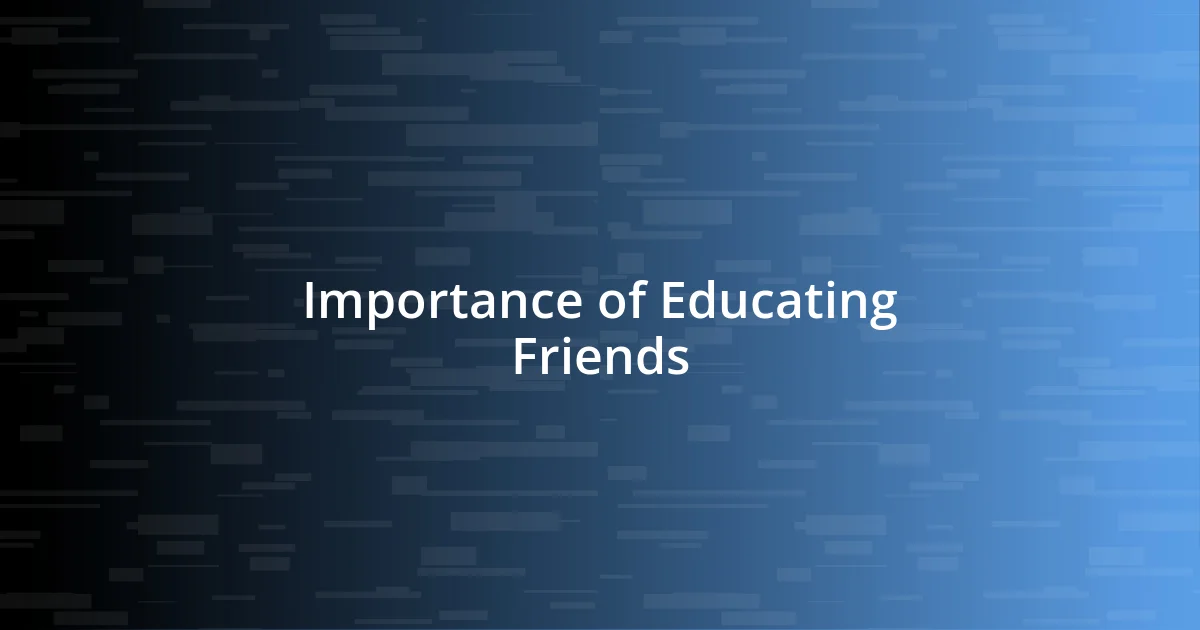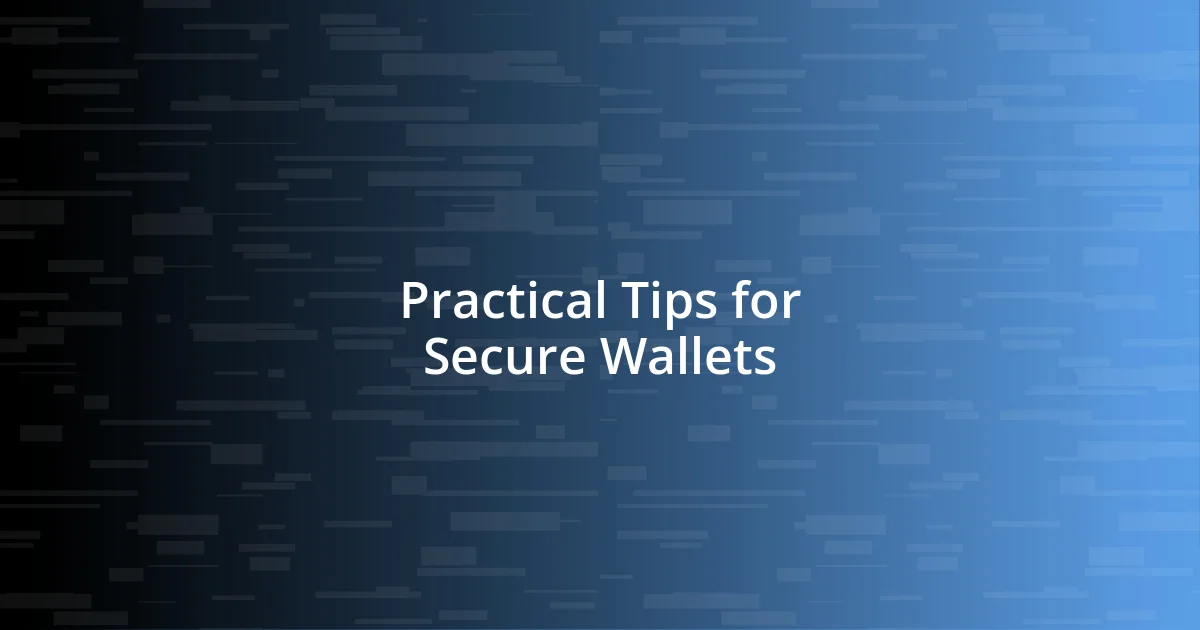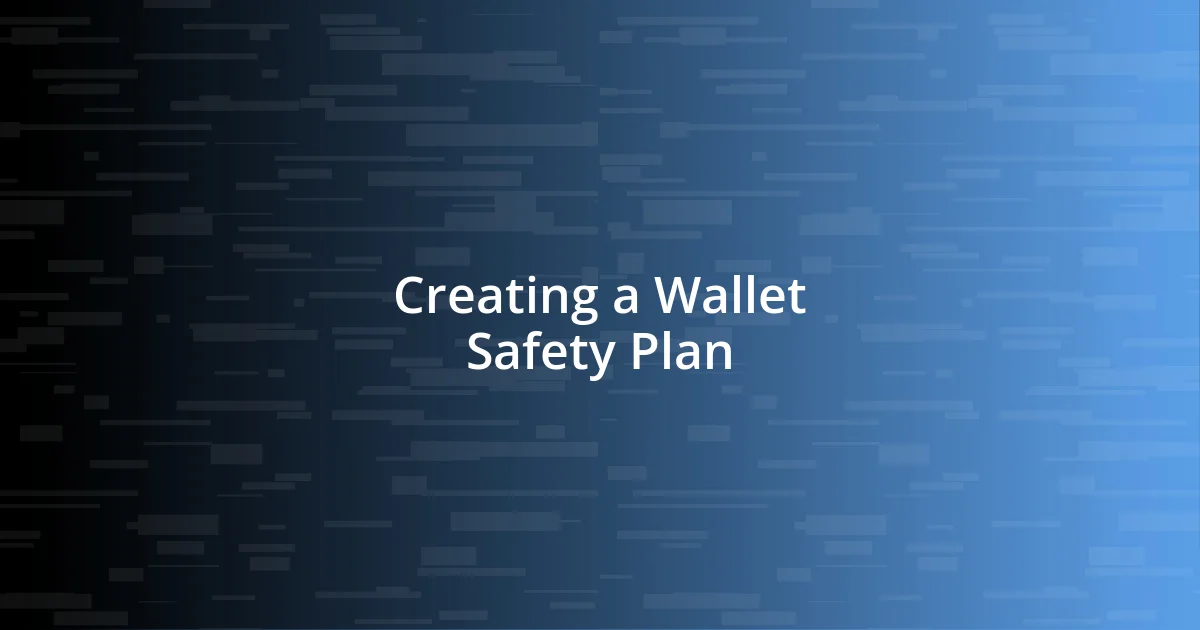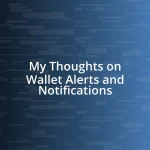Key takeaways:
- Enabling two-factor authentication and using strong, unique passwords are essential steps for enhancing wallet security.
- Educating friends and engaging in open discussions about wallet safety fosters a supportive community and reduces the risk of financial loss.
- Creating a wallet safety plan, including regular check-ins and staying informed about emerging threats, empowers individuals to protect their digital assets effectively.

Understanding Wallet Safety Risks
When I first started using digital wallets, I underestimated the risks they posed. I remember a close friend sharing a story about losing hundreds of dollars because they didn’t enable two-factor authentication. It made me realize how easily we can become complacent, thinking that a simple app is inherently safe. Have you ever considered what could happen if your wallet was compromised?
There’s a real emotional toll that comes with the possibility of losing access to funds. I once spoke with someone who had their identity stolen through a wallet breach, and the aftermath was draining—both financially and mentally. This experience highlighted to me that wallet safety isn’t just about the potential monetary loss; it’s about the stress and uncertainty that follow.
The landscape of wallet safety is riddled with risks, like phishing scams that might trick even the most cautious users. It’s vital to remain vigilant because these scams often look legitimate at first glance, making it easy to let your guard down. Have you considered how often we share personal information online without realizing the potential for harm? Understanding these risks is crucial to safeguarding your assets.

Importance of Educating Friends
Educating friends about wallet safety is incredibly important. I consider it my responsibility to share knowledge that can help prevent them from facing the same pitfalls I’ve encountered. Just recently, I was at a dinner party when a friend admitted they didn’t fully understand what two-factor authentication meant. I couldn’t help but feel a sense of urgency to explain how this simple step could greatly enhance their digital security.
- It fosters a sense of community; we look out for one another.
- It reduces the likelihood of financial loss within my circle.
- It empowers my friends to take proactive steps in managing their finances.
In another instance, a colleague trusted a new wallet app that seemed sleek and user-friendly but turned out to be a sophisticated scam. Hearing their frustration reminded me how crucial communication is in these matters—sometimes, it takes just one conversation to equip someone with the knowledge that can save them from distress. Wallet safety isn’t just a personal concern; it’s a collective one that binds us together.

Practical Tips for Secure Wallets
When it comes to securing a digital wallet, enabling two-factor authentication is a must. I remember the moment I realized how essential this feature is after my cousin lost his savings due to a simple password compromise. By adding an additional layer, like a text message code or authentication app, we can go a long way in ensuring our accounts are less vulnerable. Have you set up two-factor authentication on your wallets yet? If not, I highly recommend doing so—it’s such a simple yet effective step.
Keeping your wallet software updated is another practical tip I always share with my friends. I learned this lesson the hard way during a time when my wallet app was exploited due to outdated software. My friend was so hesitant about updates, claiming they were a hassle, but I pointed out that those updates often patch critical security vulnerabilities. Regularly upgrading your wallet ensures you’re always protected against the latest threats. So, have you checked if your wallet app is up to date?
Lastly, using strong and unique passwords for your wallet is a non-negotiable aspect of wallet safety. A few months ago, I helped a friend recover from a breach where they used the same password across multiple apps. This scenario taught me the importance of using a password manager to create unique passwords—one for every service. I often remind my friends that robust, varied passwords act like a bulwark against unauthorized access. It really makes a difference in safeguarding digital assets.
| Tip | Description |
|---|---|
| Enable Two-Factor Authentication | Add an extra layer of security to your wallet by requiring a secondary form of verification. |
| Keep Software Updated | Regular updates patch security vulnerabilities, making your wallet more secure against threats. |
| Use Strong Passwords | Create unique passwords with a password manager to enhance security for each service. |

Best Wallet Safety Practices
A solid practice I always emphasize is being vigilant about recognizing phishing attempts. I can still remember a time when I almost fell for a slick email that looked just like a legitimate wallet service. The moment I paused to scrutinize the sender’s address, it became clear that something was off. I share this experience with friends to encourage them to always double-check before clicking any links. It’s amazing how a minute of caution can save hours of stress!
Another vital aspect is securing your device. I recall the panic I felt when I misplaced my phone at a café, knowing it held all my sensitive information. The moment I realized the importance of setting a strong screen lock and using the “find my device” feature was a game-changer for me. I urge my friends to consider how easily someone could access their wallets if their phone is left unprotected. Have you thought about what might happen if your device fell into the wrong hands?
Lastly, I can’t stress enough the importance of embracing secure connections. I once had a casual lunch where a friend casually connected to a public Wi-Fi network, completely oblivious to the risk it posed. I shared my concern about how hackers can easily intercept data on these networks, leading to potential financial loss. Now, I encourage everyone to use a VPN when accessing their wallets on public networks, making it a non-negotiable part of their online habits. Are you taking the right precautions when it comes to your internet connection?

Communicating About Wallet Safety
When discussing wallet safety, I find that open and honest communication is key. One approach I take is to share personal stories, like the time I had a friend who mistakenly gave out sensitive information because they didn’t recognize a phishing message. Exploring those moments helps my friends understand the real risks we face online. Have you ever experienced something similar? Relating these experiences can make the topic feel more immediate and real.
I also encourage my friends to ask questions freely about any security practices they might be unsure of. I remember a late-night chat with a friend who was worried about how to spot fake websites. It turned out that sharing some simple clues, like checking the URL for HTTPS or looking for contact information, helped ease their mind significantly. By fostering an open environment, we can empower each other to stay informed and proactive.
Utilizing group chats can be another effective way to keep wallet safety top of mind. For instance, I once set up a group where we shared tips and articles related to online security. It became a space where everyone felt comfortable discussing their concerns and sharing new findings. Have you thought about creating a similar space? This collaborative approach not only enhances our knowledge but also builds a supportive community around digital safety.

Resources for Further Learning
One fantastic resource I often recommend is online courses focusing on cybersecurity basics. I remember taking a short course that broke down complex concepts into easy-to-understand modules. It was eye-opening to realize how much I didn’t know! Have you considered enrolling in a course to boost your digital literacy? Websites like Coursera and Udemy have excellent options that can really empower you.
Additionally, I can’t stress enough the value of following trustworthy blogs and YouTube channels dedicated to wallet safety and cybersecurity. I personally enjoy a particular YouTube series that reviews various wallet apps, highlighting their security features. This practical insight not only helps me make informed decisions but also allows me to pass valuable information to my friends. Have you found any bloggers or creators that resonate with you on this topic?
Lastly, I think joining online forums or communities can be incredibly beneficial. For instance, I took part in a discussion group on Reddit where people freely exchange tips and experiences about wallet safety. Engaging with others who face similar challenges can provide real-world solutions and support. Have you ever connected with a community like this? It’s fascinating to see how shared knowledge can create a collective awareness of the best practices in wallet safety.

Creating a Wallet Safety Plan
Creating a wallet safety plan is one of the most empowering steps I take. I remember when I sat down to brainstorm my own strategy—listing out unique passwords for each account felt a little daunting at first. But now, I use a password manager, which has made all the difference! Have you tried finding a tool that makes this process easier?
One key component of my wallet safety plan is to establish regular check-ins with my friends. For instance, monthly catch-ups where we review our security practices can lead to valuable discussions. Just the other day, during one of these meetings, a friend discovered that their two-factor authentication wasn’t enabled. It brought home the importance of not only having a plan but also routinely updating it. Do you think it’s manageable to set aside time each month for this type of reflection?
Lastly, I make it a point to stay informed about emerging threats. I remember a time when a new phishing scheme targeted popular apps, and I couldn’t believe how quickly everyone was at risk. Keeping updated through apps or newsletters can be a game-changer. What sources do you follow to learn about the latest in wallet safety? Building this knowledge base is crucial, and it allows me to not just protect myself but also to advise friends on potential risks.














